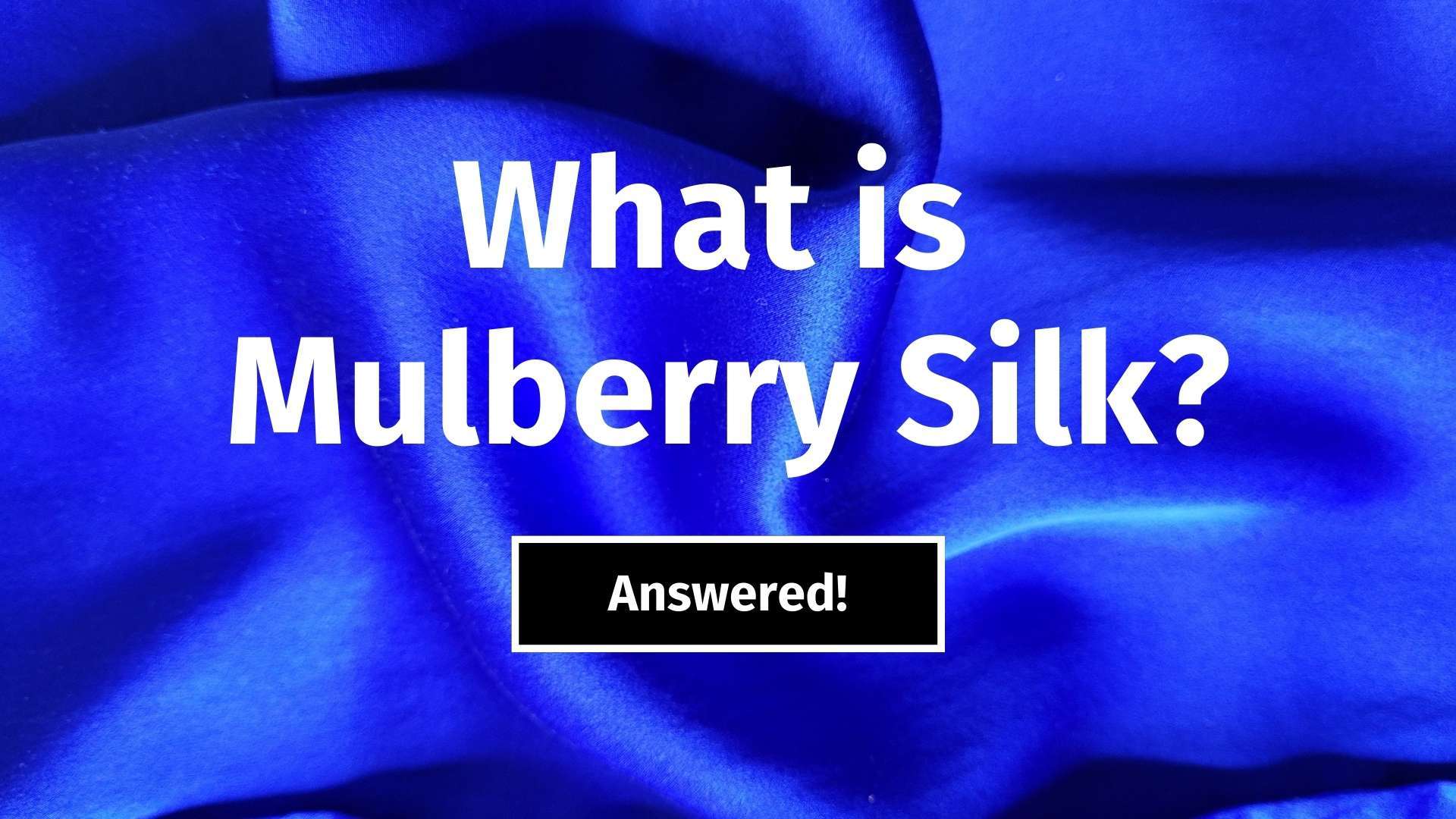Mulberry silk is produced by silkworms who live and feast on mulberry leaves until they are fully grown and are able to produce a cocoon. This cocoon is then boiled in hot water so that the long silk thread can be extracted, spun, and woven into useful textile. Mulberry silk is the finest type of silk in existence and predominantly comes from China. Mulberry silk is typically used to make silk shirts and blouses, silk pillowcases and bedsheets, silk pajamas, and silk dresses.
This is: What is Mulberry Silk?

Mulberry silk is a soft, smooth, lightweight, and comfortable fabric that is commonly used to make shirts, blouses, pajamas, and bedding.
Mulberry silk is made through a 7 step production process that is outlined in the article below.
Continue reading to learn more about mulberry silks production, where it comes from, and more!
Contents:
What is Mulberry Silk?
Mulberry silk is the finest type of silk in existence. It's long, smooth, and strong strands produce incredibly soft and luxurious fabric that is used in a variety of garments and upholstery.
Mulberry silk is a remarkable fabric with luxurious qualities and a long and ancient history. Mulberry silk is more expensive than almost all other types of natural and synthetic fabrics because of its premium look and delicate feel. Mulberry silk is highly popular around the world and makes up approximately 85% percent of global silk production.
Where Does Mulberry Silk Come From?
China, with more than 4,000 years of experience in the silk trade, not only produces the highest quality mulberry silk in the world, but they also dominate in terms of production volume by producing around 75% of the world's mulberry silk every year.
India is a distant second behind China when it comes to production of silk and mulberry silk. China produces about 6 times as much mulberry silk as India, and dwarfs other silk producing nations such as Uzbekistan, Japan, Brazil, Thailand, and Vietnam.
How is Mulberry Silk Made?
The production of Mulberry Silk is initiated naturally and organically when silkworms, specifically the Bombyx mori silkworm, are fed mulberry leaves in order to grow to full size and eventually produce cocoons. These cocoons eventually become silk fabric through a series of steps and procedures.
There are 7 necessary steps followed during the production cycle of mulberry silk, below we briefly discuss each step.
If you would like even more information relating to the production of silk, please read How is Silk Made.
1. Sericulture
Sericulture is more simply known as silk farming, and is the process of nurturing silk worms and feeding them mulberry leaves until they are fully grown and ready to spin their cocoon.
The eggs of silkworms are laid on luscious beds of fresh green mulberry leaves where they begin to eat and grow into full sized silkworms. After about 4-6 weeks of overindulging on mulberry leaves the silkworms become fully grown and are ready to start spinning their cocoons.
Once these restless silkworms begin spinning their cocoon it will take about 3-8 days until they are fully finished spinning. Once done, each silk worm will have produced 1 single strand of mulberry silk that measures up to 100 meters in length.
This is the amazing and natural first step in silk production!
2. Thread Extraction
Once the silkworm's cocoon is fully developed it will then be placed into a pot of boiling hot water. The boiling water works to soften and unravel the cocoon which then allows for the fibers to be extracted and spun on a reel.
3. Dying
The next step in the production process is to dye and add beautiful colors to the mulberry silk fibers. The reason mulberry silk carries such bright and vibrant colors is because of its ability to soak up and retain those colors during the dyeing process.
To prepare the silk for dyeing, the strands must first be bleached and dried. Once this is complete the silk is then then submerged in a dye bath for approximately one hour, depending on how vibrant the color is intended to be.
4. Spinning
The silk spinning wheel has been used during the production of silk throughout its entire known history. As technology has advanced during the 4000 year history of silk, the traditional spinning wheel remains unchanged and still plays a crucial roll in its production.
The purpose of spinning is to unwind the fibers after dying, so that they can be laid flat and neat on a bobbin in preparation for the next essential step; weaving.
5. Weaving
Weaving is when the individual silk strands of mulberry silk finally come together to become a proper silk fabric. Weaving is the process of interlocking 2 silk strands around one another so that they become strong, durable, and useful.
The three most popular types of silk weaves that you will come across are:
- Satin
- Open
- Plain
6. Printing
Printing will only take place if the mulberry silk fabric requires a pattern or unique design. If the silk only needs to be one solid color we would not need to do any printing, instead we would only complete the dyeing process, which was step #3.
The most effective way to print designs on silk is by using a digital printer. Some may also choose the more traditional and laborious method of printing, which is screen printing. While a hobbyist may wish to screen print silk, digital printing is the much more efficient and widely used method when it comes to the commercial production of silk products.
7. Finishing
The last step in the production of mulberry silk involves administering a number of different fabric treatments, with the end result being the bright and sparkling silk fabric that we have all come to adore. This finishing step adds that glossy, bright, luxurious glow to the mulberry silk fabric.
Qualities of Mulberry Silk
Mulberry silk is an incredible fabric and is regarded as the finest type of silk for a variety of different reasons, including that:
- Mulberry silk fabric offers a high level of comfort and breathability
- Mulberry silk is hypoallergenic
- Mulberry silk fabric is durable and odorless
- Compared to other types of silk, Mulberry is more uniform in texture
- Mulberry Silk produces the longest strands of silk
Mulberry silk pleases all the senses and is unmatched in terms of comfort, beauty, style, and luxury. Mulberry silk has been sought after for thousands of years because of its tremendous qualities and the special experience it brings each and every time you wear it. No clothing collection is complete without a piece of clothing made from premium 100% mulberry silk fabric.
How to Wash Mulberry Silk
The best way to wash mulberry silk is by hand washing.
To wash mulberry silk by hand first fill a basin with cool to lukewarm water not exceeding 77°F/25°C in temperature and add a few drops of pH neutral silk laundry detergent.
Turn your garment inside out and submerge it in the water for 3 minutes. Once 3 minutes has elapsed use your hands to agitate the garment in the water.
Once finished remove the mulberry silk garment and rinse it under a tap until the cool water runs clear and all the soap has been removed.
Learn more about How to Wash Mulberry Silk.
Related: How to Wash Silk
What is Mulberry Silk FAQ
Is mulberry real silk?
Mulberry silk is real 100% silk and is considered to be the finest type of silk. Mulberry silk is made when silkworms eat mulberry leaves and create cocoons. The mulberry silk threads are then extracted from the cocoon, dyed, spun, and weaved into mulberry silk fabric.
What is the difference between silk and silk mulberry?
There are an abundance of different types of silk fabrics and mulberry silk is just one of the many. Silk fabrics are distinguished from one another by the momme, weave, and production methods use to create the fabric.
Is mulberry silk natural or synthetic?
Mulberry silk is 100% natural and is produced by silkworms living on silk farms. The silkworms feast on mulberry leaves until they are fully grown and ready to spin their cocoons. Once the cocoon is spun, it is then boiled in hot water so it can be extracted, dyed, spun, and weaved into luxurious mulberry silk fabric.

